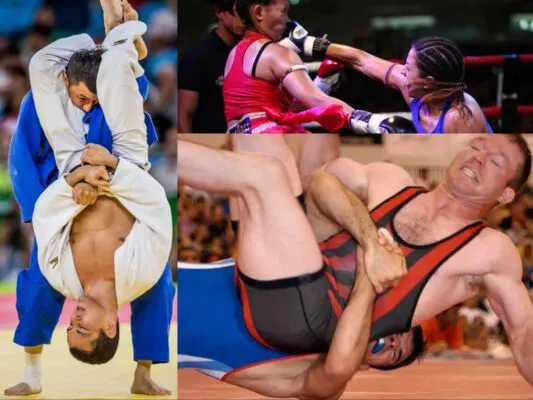
Mixed Martial Arts (MMA) is a sport which has been growing over the last three decades. Its electrifying bouts have showcased a diverse range of different martial arts and martial artists from all over the world, who have wowed the crowd with their speed, technical brilliance and athleticism. It has also been a testing ground to find which martial arts styles are more efficient and effective than others.
Overall, when it comes to preparing for striking in MMA, fighters use techniques from boxing, Muay Thai, and kickboxing. In contrast, they mostly use wrestling and Brazilian jiu-jitsu techniques for ground fighting in MMA.
Let me now easily explain to you these martial arts styles used in MMA fighting and some crucial information about how fighters started mixing different martial arts. These martial arts combine striking and grappling techniques to create the versatile and powerful MMA fighters you see today. So let’s go!
When Did Fighters Start Mixing Martial Arts?
Although in the 1990s UFC fighters typically represented one fighting style, cross-training began to be seen more and more in the early ’00. Competitors began to recognize that if they were equipped with only one style, they could find themselves countered by a well-trained, knowledgeable opponent. Bringing in an additional style granted fighters a degree of unpredictability. If they found their takedowns stuffed, they could throw strikes into the mix.
Mixing striking with grappling led to the development of various combinations still seen in MMA. If a fighter was struggling to get a takedown, they could set it up with a punch or series of punches. A fighter with a strong overhand right could fake a takedown attempt and, with their opponent being likely to drop their hands in an attempt to stuff the feint, be able to land the punch with both power and devastating accuracy.
The concept of the “Hybrid” fighter was more thoroughly established in the mid to late ’00s, with men like Randy Couture and Chuck “The Iceman” Liddell showing how effective striking arts could be mixed with high-level wrestling.
Wrestlers might have also sought to pick up Brazilian Jiu-Jitsu skills to help them develop their arsenal of submissions and allow them to fight off their backs better. Conversely, the BJJ practitioners may have taken up wrestling or judo classes to ensure that they could take their opponents to the ground.
From the early to mid-2010s, there appeared to be more of a striking revolution, with fighters such as Conor McGregor showing how footwork and different patterns of movement could be even more unpredictable. For the fans, particularly the casual ones, striking is often much more exciting to watch than the technical grappling, which might appear to be aggressive ground-hugging to the untrained eye.
The modern MMA athlete is expected to be competent in almost all areas of the game, adopting MMA-specific training methodologies, strength, and conditioning. Fighters cross-train with the focus on creating a blend that suits their individual strengths.
What Martial Arts Are Used in MMA Fighting?
While MMA competitions have seen practitioners of many different arts test their abilities in rings and cages over the years, over time, certain martial arts have become favored for their ease of learning and efficiency in competition.
We’re going to break down which martial arts have shown the most dominance in MMA. As a general rule, the martial arts practiced in the UFC fall into two categories: striking and grappling.
Most Commonly Used Striking Arts in MMA
The three most commonly used striking martial arts in MMA are boxing, Muay Thai, and kickboxing.
Boxing
Almost every fighter, whether predominantly a wrestler or striker, will train in western boxing to some level. This is in part due to the fact that boxing strikes are so efficient both inside and outside of the clinch and because boxing teaches intelligent distance management and head movement. Simply put, no other combat art teaches better hand striking than boxing does.
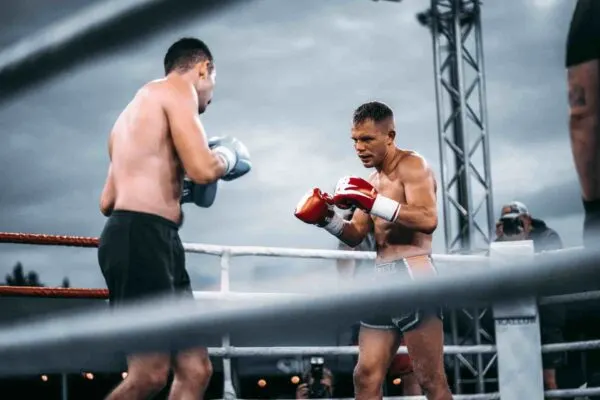
As stated by Conor McGregor’s striking coach, Owen Roddy, roughly 80% of all strikes thrown in MMA are punches, with kicks making up the majority of the remaining 20%. For this reason, boxing has become an essential component of MMA training to enhance hand striking skills.
Muay Thai
Muay Thai is the second most commonly practiced striking art because it specializes in low kicks, knees, elbows, and clinching techniques on top of punches.
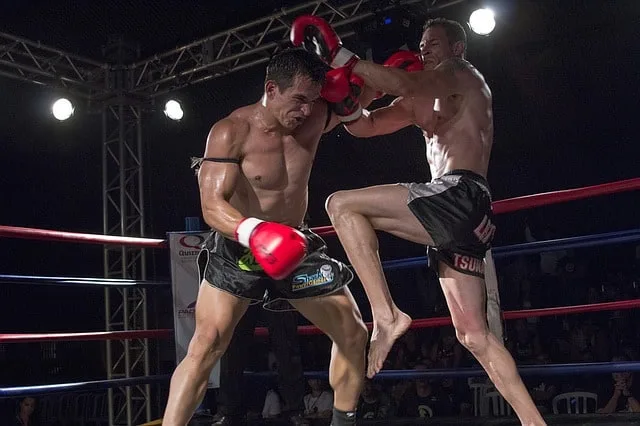
Since MMA rules allow knee strikes, low kicks, elbow strikes, and clinching techniques, all fighters train in Muay Thai to learn the proper execution of these strikes to enhance their fighting arsenal and increase their chances of winning. This not only makes a fighter more versatile but more unpredictable, too.
Kickboxing
Kickboxing, a combat sport derived from a combination of Kyokushin Karate and Muay Thai, has produced numerous UFC champions renowned for their kickboxing prowess, including Michael Bisping, Alex Pereira, and Israel Adesanya. Like boxing, kickboxing can equip a fighter with great footwork and distance management, and while it may not have knees or elbow techniques, it has a greater focus on different kicks.
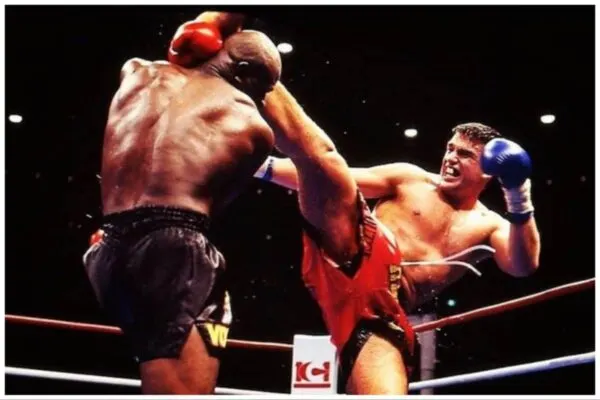
These kicks might include spinning kicks, question mark kicks, hook kicks, axe kicks, heel kicks, or jumping kicks, and while they might exist in Muay Thai, they are rarely focused on due to their perceived inefficiency in the sport.
Most Commonly Used Grappling Arts in MMA
Wrestling
As an Olympic sport, it has a history that stretches back to 776 BC. Today, wrestling is considered the most dominant martial art that is used in MMA. Good wrestling training can help a fighter take down their opponent to the ground, forcing them to fight off their back, significantly limiting their ability to strike back, and improving their probability of winning a fight.

You often see high-level strikers in the UFC struggle against high-level wrestlers. As an example, during the fight at UFC 267, Li Jingliang, a highly skilled striker, faced off against Khamzat Chimaev, a highly skilled wrestler. In the fight, Khamzat quickly took Jingliang down to the ground, where Jingliang was unable to fight back or move, giving Khamzat en route to easy victory via rear-naked choke.
Wrestling training is some of the most grueling, militant, and aggressive training of all martial arts. Those who dedicate themselves develop incredible strength, stamina, speed, and tenacity with a comparatively low risk of injury compared to striking arts.
In the US and Russia, wrestling training might start at the elementary school level, with children as young as 4 or 5 learning basic techniques.
Brazilian Jiu-Jitsu
Brazilian Jiu-Jitsu (BJJ), which completely dominated the early years of MMA and gave rise to the UFC, is a grappling art that has continued to evolve since its inception in the 20th century.
BJJ is derived from Judo and Japanese Jiu-Jitsu, which preceded it, but also takes some techniques from catch and freestyle wrestling.
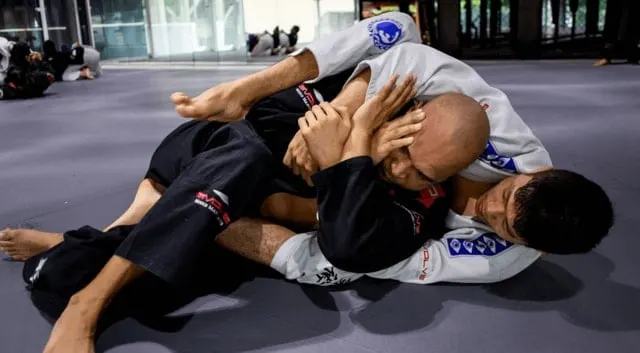
What makes Brazilian Jiu-Jitsu particularly effective is the numerous submission holds and a particular focus on the guard position (see the video clip below). The guard position is a defensive position that allows a grappler to fight off of their back, either allowing them to sweep or submit their opponents.
While fewer champions have BJJ as their base martial art, almost all MMA fighters will incorporate BJJ training into their schedules. This even includes wrestlers who may, despite being able to control their opponents in the clinch or in a top position, may not have the same ground-fighting skills to get back to a dominant position or onto their feet if they themselves are taken down.
There has been an explosion of BJJ gyms open all over the world, and training has made it incredibly accessible for the average person in many parts of the globe. This accessibility has allowed many fighters to add BJJ to their arsenal.
The Rest of the Other Martial Arts
In the early days, there was a much wider range of martial arts practiced, but this range has greatly diminished over time. Outside of the above-mentioned grappling and striking arts, there are a number of lesser-seen martial arts.
The Japanese art and sport of Judo has been part of various fighter’s training regimes, but few fighters have come from it. Despite this, the sport of women’s MMA would not be where it is today if it weren’t for former Olympian and current WWE wrestler Ronda Rousey. Rousey’s ability to hip toss then armbar her opponents through her high-level grappling skills allowed her to become one of the most dominant champions of all time.
Various high-level fighters have showcased their Karate skills. These include former light heavyweight champions Lyoto Machida and Chuck Liddell, who practice Shotokan Karate and American Kenpo, respectively, former middleweight champion Robert Whittaker, who practiced Goju-Ryu and Hapkido as a child, and high-ranked welterweights, such as fan favorites Steven Wonderboy Thompson, Michelle Waterson and Michel Pereira. Let’s not forget arguably the greatest of all time, George Saint Pierre, being a black belt in Kyokushin karate.
Other high-level strikers may have originally come from Taekwondo backgrounds – another candidate for GOAT status, former middleweight champion Anderson Silva, is a black belt in Taekwondo. Rose Namajunas, Anthony Pettis, and Valentina Shevchenko all trained in Taekwondo before studying other arts.
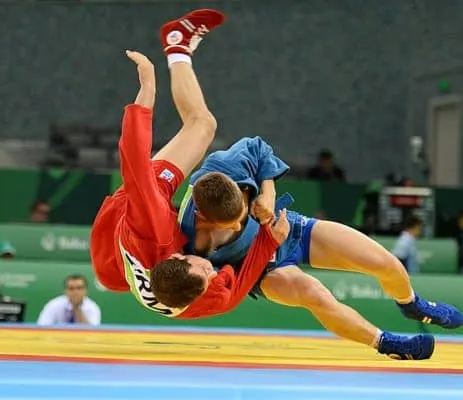
Credit: President.az
The Russian art of Sambo, which mixes Judo techniques, striking, and wrestling, has produced numerous champions, including Fedor Emelianenko and Dagestani wrestlers – Khabib Nurgamedov and Islam Makhachev, to name just a few.
Can You Use Any Types of Martial Arts in MMA?
You can use any martial art if you follow the Unified Rules of Mixed Martial Arts. As such, fighters in MMA can use any martial art, but they use the striking and grappling arts that have been proven effective in combat situations. Obscure martial arts are far less commonly used.
Some martial arts appear to have unrealistic techniques, and others have no full contact live sparring, which ultimately makes them less applicable in the cage. Forms-based or dance-orientated martial arts are particularly limited in their scope of use in the cage.
What Martial Arts Are Not Allowed in MMA?
Almost any martial art can be used in MMA, but there are certain martial arts or combat systems that cannot be used in MMA because these arts mainly focus on techniques that are banned in MMA.
As MMA is a sport, headbutts, minor joint manipulation, fish hooking, groin strikes and eye gouges are all banned. To name a few, Krav Maga, Pencak Silat, and Muay Boran are all arts that have these banned techniques as part of their syllabus that cannot be used in MMA. These martial arts are designed for battlefield or self-defense scenarios, which involve banned attacks.
Weapons based martial arts such as fencing, Historical European Martial Arts, Kendo, Eskrima also cannot be used in MMA as the sport allows unarmed hand to hand combat only.
Can Krav Maga Be Used in MMA?
Krav Maga isn’t a sport used in Mixed Martial Arts competitions. This is because it’s a self-defense system focusing on practical and efficient techniques for defending oneself in real-life situations such as on the street, bar, or even on the battlefield.
Although Krav Maga may incorporate boxing techniques, knees, elbows, and leg kicks seen in Muay Thai, Krav Maga has no rule set, and practitioners will also use illegal attacks – eye gouges and groin strikes to immobilize attackers or allow the user to escape.
Krav Maga classes are often designed to instill students with a greater sense of situational awareness—ways to prevent conflict from escalating than fighting in rule-based competitions. Therefore, Krav Maga just doesn’t fit in MMA competition.
Are There Kung Fu Fighters in MMA?
The phrase Kung Fu is a misused phrase some people use to describe Chinese martial arts. In its traditional sense, “kung fu” translates to “skill achieved through hard work and effort,” and the word “wushu” is more commonly used in China to describe martial arts.
There are various wushu fighters who compete in MMA, but rather than being Shaolin monks or those practicing some mystical “Tiger Style” you might see in a ’70s Hong Kong action film or mentioned in a Wu-Tang Clan song, these fighters display high-level use of Sanda or Sanshou – a full contact sport martial art akin to kickboxing with takedowns and throws integrated into the art.
Martial artists such as former Strikeforce middleweight champion Cung Le and UFC women’s strawweight champion Zhang Weili have been associated with the Chinese arts.
